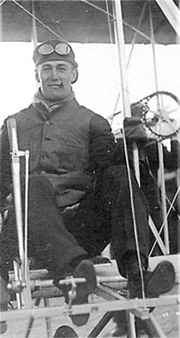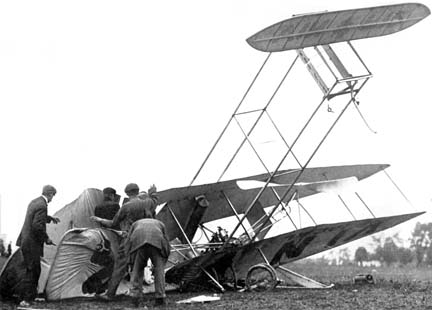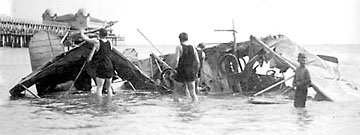
The Epic Flight of the Vin Fiz Flyer

The First Crossing of America By Air
  In 1911, 32-year-old Calbraith Perry Rodgers took flying lessons from Orville Wright amounting to all of 90 minutes. With that under his belt, he purchased a new Flier, the first Wright ever sold to a private buyer, and went off to seek his fame and fortune at air meets.
In 1911, 32-year-old Calbraith Perry Rodgers took flying lessons from Orville Wright amounting to all of 90 minutes. With that under his belt, he purchased a new Flier, the first Wright ever sold to a private buyer, and went off to seek his fame and fortune at air meets.

A romantic model of a daredevil at the time, 6'4" tall and with an everpresent cigar wedged in his mouth, former football star, yachtsman, auto racer, and grandson of Oliver Perry (hero of the Battle of Lake Erie), Cal Rodgers gained early notoriety by setting aviation endurance and speed records that summer. However, the big one that would guarantee him a paragraph in history books was the challenge of crossing the nation by air, especially when publisher William Randolph Hearst dangled a $50,000 carrot for the the first one to do so in 30 days or less.

With only 60 hours in his logbook, compensated for by his bravado and self-confidence, Rodgers convinced Chicago meat packer J Ogden Armour to sponsor him in America's first flying billboard, a long-wing Wright R, modified for the flight as EX, with the name "Vin Fiz," Armour's soft drink, spelled out on its rudders and underwings.

The plane, frail by today's standards, was state-of-the-art in 1911—a linen-covered, spruce-framed biplane with a 35hp water-cooled motor chain-driving two eight-foot pusher propellers. Rodgers would face a roughly 4,000-mile flight perched out in front, flying without instruments or navigational aids or maps, certainly no heater or other creature comforts, at a breathtaking (and time-consuming) 45 to 55 miles per hour. A bucket seat, an unlit cigar, and a wide nation to conquer... and not a single airport or guiding beacon ahead.

Armour arranged to have a special, three-car train filled with spare parts, fuel, two mechanics and two assistants, even Rodgers' wife, Mabel, his mother, and friend Charlie Wiggin. One car was a Palmer-Singer touring coach for accommodations, and a baggage car was outfitted as a repair shop. In keeping with the advertising blitz, the train, as well, was emblazoned with "Vin Fiz" on its sides, and would sometimes follow, sometimes lead in the journey, since Rodgers' planned route used railroads as his principal guide—the old-time flyer's famous "iron compass"—over the paths of least resistance and around fewer mountains.

  At 4:30 on the afternoon of September 17, 1911, dressed in a business suit and tie sheltered under layers of sweaters and a sheepskin vest, his epic began in an open field at Sheepshead Bay, near New York City. Somewhat less than a cheering mob was witness to the takeoff since there were odds-on bets that the flight wouldn't make it past the Hudson River. But Cal fooled them. His first leg that day ended uneventfully at Middletown NY, a 104-mile trip taking nearly two hours.
At 4:30 on the afternoon of September 17, 1911, dressed in a business suit and tie sheltered under layers of sweaters and a sheepskin vest, his epic began in an open field at Sheepshead Bay, near New York City. Somewhat less than a cheering mob was witness to the takeoff since there were odds-on bets that the flight wouldn't make it past the Hudson River. But Cal fooled them. His first leg that day ended uneventfully at Middletown NY, a 104-mile trip taking nearly two hours.

Events took a bad turn the next morning when he snagged a tree with his wheel on takeoff and crashed into a chicken shed. Dazed and bleeding from a cut on his scalp, Rodgers climbed out of the wreckage to face an irate farm wife who demanded immediate payment for the damage. Three days were required to put Vin Fiz back in flying shape, then a series of other mishaps and accidents plagued his trip, slowing his progress. When he finally arrived at Chicago on October 9, it was soberingly apparent that there was little chance of capturing the Hearst money. However, still dogged in his persistence, and with basic funding by Armour—whose expenses added up to about $23,000 in 1911 dollars—he was determined to complete his conquest of the USA.

 During the rest of the flight, which dragged through October and into November for a total of 49 days, Vin Fiz suffered a series of mishaps numbering anywhere from 16 to 39—an exact total was never calculated since definitions between rough landings and uncontrolled crashes were at the mercy of intensities and dramatic content, not to mention folklore. In 69 stops across the country (23 in Texas alone), the attrition was demonstrated by only one rudder and a single wing strut remaining from the original aircraft by the end of the flight. Of those 49 days, only 82 hours and 4 minutes were spent in the air! Distance covered has never been verified—varied estimates put it at anywhere from 3,220 to 4,251 miles. Average groundspeed was a brisk 51.6 mph!
During the rest of the flight, which dragged through October and into November for a total of 49 days, Vin Fiz suffered a series of mishaps numbering anywhere from 16 to 39—an exact total was never calculated since definitions between rough landings and uncontrolled crashes were at the mercy of intensities and dramatic content, not to mention folklore. In 69 stops across the country (23 in Texas alone), the attrition was demonstrated by only one rudder and a single wing strut remaining from the original aircraft by the end of the flight. Of those 49 days, only 82 hours and 4 minutes were spent in the air! Distance covered has never been verified—varied estimates put it at anywhere from 3,220 to 4,251 miles. Average groundspeed was a brisk 51.6 mph!

When he finally landed at a race track in Pasadena on November 5, Rodgers was already a national celebrity, and some 20,000 people were waiting to watch him land. Newspapers had faithfully recorded his progress, and towns along the route held celebrations when they knew he was coming. Never one to turn his back on the public, he would often favor local folks with aerobatic flights, one time even doing a brief show over an Illinois penitentiary when he learned that the warden was going to release prisoners into the yard just to watch him pass—most had never seen an airplane.

Much of the flight found Rodgers with bandages somewhere on his person, even one leg in a cast after a crash in Arizona. Only 200 miles short of his goal, the motor blew a cylinder and sent shrapnel into his right arm, which necessitated an emergency landing and medical attention, and yet another bandage.


In retrospect, the flight of Vin Fiz was almost comedic in regard to expense of time and money and the hardships and the number of crashes, and certainly has since been often made light of, but the underlying magnitude of Rodgers' accomplishment cannot be denied. He was our nation's first pioneer aviator as such, daring to go where no human had ever gone before. His feat earned him a place of honor in Dayton's Aviation Hall of Fame. There is no telling how much more he would have accomplished in subsequent episodes had it not been for a tragic incident four months after his transcontinental flight. On April 3, 1912, while flying an exhibition near Long Beach, he apparently struck a seagull, which fouled his controls and caused him to crash into the breakers. Cal Rodgers, the man that shrunk a nation, died of a broken neck at age 33. (— K O Eckland)



The salvageable remains of the original Vin Fiz were disposed of long ago, according to Orville Wright*, but NASM has an accurate reproduction of the craft on display honoring Rodgers' epic flight. (* letter, Aero #149, page 122)
|





 During the rest of the flight, which dragged through October and into November for a total of 49 days, Vin Fiz suffered a series of mishaps numbering anywhere from 16 to 39—an exact total was never calculated since definitions between rough landings and uncontrolled crashes were at the mercy of intensities and dramatic content, not to mention folklore. In 69 stops across the country (23 in Texas alone), the attrition was demonstrated by only one rudder and a single wing strut remaining from the original aircraft by the end of the flight. Of those 49 days, only 82 hours and 4 minutes were spent in the air! Distance covered has never been verified—varied estimates put it at anywhere from 3,220 to 4,251 miles. Average groundspeed was a brisk 51.6 mph!
During the rest of the flight, which dragged through October and into November for a total of 49 days, Vin Fiz suffered a series of mishaps numbering anywhere from 16 to 39—an exact total was never calculated since definitions between rough landings and uncontrolled crashes were at the mercy of intensities and dramatic content, not to mention folklore. In 69 stops across the country (23 in Texas alone), the attrition was demonstrated by only one rudder and a single wing strut remaining from the original aircraft by the end of the flight. Of those 49 days, only 82 hours and 4 minutes were spent in the air! Distance covered has never been verified—varied estimates put it at anywhere from 3,220 to 4,251 miles. Average groundspeed was a brisk 51.6 mph!